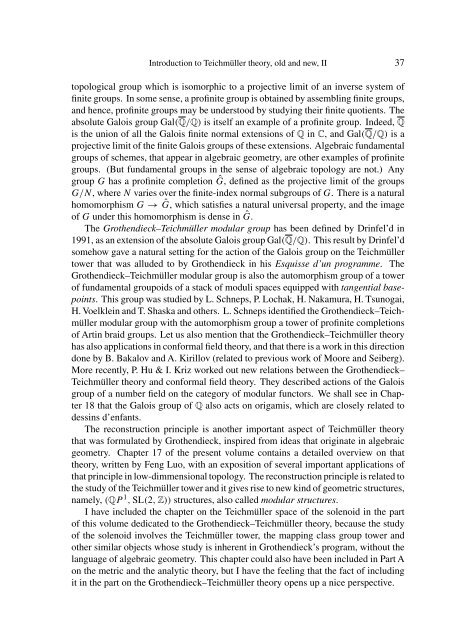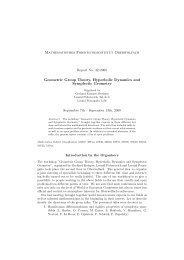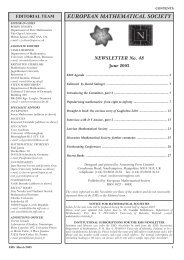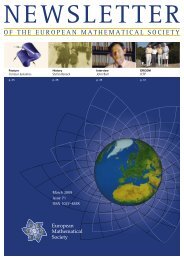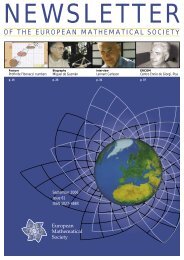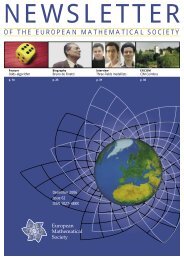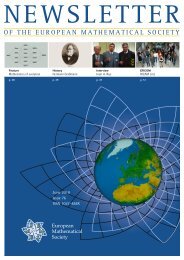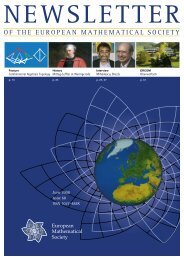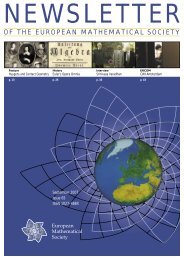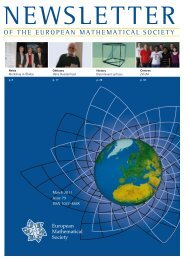Introduction to Teichmüller theory, old and new, II
Introduction to Teichmüller theory, old and new, II
Introduction to Teichmüller theory, old and new, II
You also want an ePaper? Increase the reach of your titles
YUMPU automatically turns print PDFs into web optimized ePapers that Google loves.
<strong>Introduction</strong> <strong>to</strong> <strong>Teichmüller</strong> <strong>theory</strong>, <strong>old</strong> <strong>and</strong> <strong>new</strong>, <strong>II</strong> 37<br />
<strong>to</strong>pological group which is isomorphic <strong>to</strong> a projective limit of an inverse system of<br />
finite groups. In some sense, a profinite group is obtained by assembling finite groups,<br />
<strong>and</strong> hence, profinite groups may be unders<strong>to</strong>od by studying their finite quotients. The<br />
absolute Galois group Gal(Q/Q) is itself an example of a profinite group. Indeed, Q<br />
is the union of all the Galois finite normal extensions of Q in C, <strong>and</strong> Gal(Q/Q) is a<br />
projective limit of the finite Galois groups of these extensions. Algebraic fundamental<br />
groups of schemes, that appear in algebraic geometry, are other examples of profinite<br />
groups. (But fundamental groups in the sense of algebraic <strong>to</strong>pology are not.) Any<br />
group G has a profinite completion ˆG, defined as the projective limit of the groups<br />
G/N, where N varies over the finite-index normal subgroups of G. There is a natural<br />
homomorphism G → ˆG, which satisfies a natural universal property, <strong>and</strong> the image<br />
of G under this homomorphism is dense in ˆG.<br />
The Grothendieck–<strong>Teichmüller</strong> modular group has been defined by Drinfel’d in<br />
1991, as an extension of the absolute Galois group Gal(Q/Q). This result by Drinfel’d<br />
somehow gave a natural setting for the action of the Galois group on the <strong>Teichmüller</strong><br />
<strong>to</strong>wer that was alluded <strong>to</strong> by Grothendieck in his Esquisse d’un programme. The<br />
Grothendieck–<strong>Teichmüller</strong> modular group is also the au<strong>to</strong>morphism group of a <strong>to</strong>wer<br />
of fundamental groupoids of a stack of moduli spaces equipped with tangential basepoints.<br />
This group was studied by L. Schneps, P. Lochak, H. Nakamura, H. Tsunogai,<br />
H. Voelklein <strong>and</strong> T. Shaska <strong>and</strong> others. L. Schneps identified the Grothendieck–<strong>Teichmüller</strong><br />
modular group with the au<strong>to</strong>morphism group a <strong>to</strong>wer of profinite completions<br />
of Artin braid groups. Let us also mention that the Grothendieck–<strong>Teichmüller</strong> <strong>theory</strong><br />
has also applications in conformal field <strong>theory</strong>, <strong>and</strong> that there is a work in this direction<br />
done by B. Bakalov <strong>and</strong> A. Kirillov (related <strong>to</strong> previous work of Moore <strong>and</strong> Seiberg).<br />
More recently, P. Hu & I. Kriz worked out <strong>new</strong> relations between the Grothendieck–<br />
<strong>Teichmüller</strong> <strong>theory</strong> <strong>and</strong> conformal field <strong>theory</strong>. They described actions of the Galois<br />
group of a number field on the category of modular func<strong>to</strong>rs. We shall see in Chapter<br />
18 that the Galois group of Q also acts on origamis, which are closely related <strong>to</strong><br />
dessins d’enfants.<br />
The reconstruction principle is another important aspect of <strong>Teichmüller</strong> <strong>theory</strong><br />
that was formulated by Grothendieck, inspired from ideas that originate in algebraic<br />
geometry. Chapter 17 of the present volume contains a detailed overview on that<br />
<strong>theory</strong>, written by Feng Luo, with an exposition of several important applications of<br />
that principle in low-dimmensional <strong>to</strong>pology. The reconstruction principle is related <strong>to</strong><br />
the study of the <strong>Teichmüller</strong> <strong>to</strong>wer <strong>and</strong> it gives rise <strong>to</strong> <strong>new</strong> kind of geometric structures,<br />
namely, (QP 1 , SL(2, Z)) structures, also called modular structures.<br />
I have included the chapter on the <strong>Teichmüller</strong> space of the solenoid in the part<br />
of this volume dedicated <strong>to</strong> the Grothendieck–<strong>Teichmüller</strong> <strong>theory</strong>, because the study<br />
of the solenoid involves the <strong>Teichmüller</strong> <strong>to</strong>wer, the mapping class group <strong>to</strong>wer <strong>and</strong><br />
other similar objects whose study is inherent in Grothendieck’s program, without the<br />
language of algebraic geometry. This chapter could also have been included in Part A<br />
on the metric <strong>and</strong> the analytic <strong>theory</strong>, but I have the feeling that the fact of including<br />
it in the part on the Grothendieck–<strong>Teichmüller</strong> <strong>theory</strong> opens up a nice perspective.


